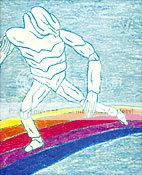Kramers Ergot 4
Anders Nilsen, David Lasky & Frank M. Young, Renee French, Lauren Weinstein, Marc Bell, John Hankiewicz, Mat Brinkman, Ron Rege Jr, Sammy Harkham, Jim Drain, Ben Jones, Dave Kiersh, C.F., Stepan Gruber, Joe Grillo, Josh Simmons, David Heatley, Souther Salazar, Genevieve Castree, Allison Cole, Leif Goldberg, Tobias Schalken, Jeffrey Brown, Billy & Laura Grant, Jason T. Miles, Kenny, Andrew Brandou, writers/artists
Sammy Harkham, editor
Avodah Books, June 2003
Pre-order a fancy-sounding hardcover re-release from Amazon.com
For me at least it’s difficult to separate Kramers Ergot 4 from how it came into my life. The book made its debut at the first MoCCA festival, joining Craig Thompson’s Blankets in the “big giant powder-blue books that knocked everyone out” sweepstakes; all three events–Kramers, Blankets, and MoCCA itself–turned out to be milestones in my comics-reading life. In terms of Kramers, even for someone weaned on Highwater and NON such as myself, this was heady stuff. I seem to remember there being passionate, even angry debates on my then-stomping grounds of the Comics Journal message board over whether it should have “wasted” pages on non-comics content like collages, and then other debates about whether those non-comics pages are, in fact, comics. It all seems pretty meaningless now–I don’t even remember what side(s) I was on–but I suppose the point is that the book really introduced me to completely non-narrative comics, a strategy I don’t think I’d given much thought to until then. I feel as though in a very real way it introduced comics to non-narrative comics, at least by virtue of becoming the most high-profile and influential release of that nature to date in the then-young decade. If you look at that contributor list and compare it to people’s 2007 Best Of lists, you can probably see the power it had.
In my defense, it is a powerful book. I would say it is in fact a book designed to overwhelm, from the sheer size of the thing to its small-army contributor list to the “yes, but is it art?” nature of so many of its contents. I mean, the textless Mat Brinkman “monsters clash on the Rainbow Bridge” cover is a statement practically begs comparison to the great Hypgnosis album covers for Led Zeppelin and Pink Floyd, even sharing a rainbow with The Dark Side of the Moon. Now that I think of it–and I promise I hadn’t, not even before my initial pass at this review–Dark Side is a great point of comparison in terms of how KE4 functions as a unit rather than as a collection of individual pieces. (There was little question in my mind as to whether I could approach talking about this anthology the same way I’ve done with MOME.)
See, one thing that struck me in giving the book a cover-to-cover read-through (the first time I’d ever done so) is that there are a surprising number of straightforward narrative strips given the book’s outré reputation. There are humor strips (Cole and Jones), autobio/slice of life (Brown), biography (Lasky & Young), underground-type sex’n’violence (Simmons), ruminative mythology-based storytelling of the kind that’s proven so popular (Nilsen), and just plain storytellin’ (Harkham). Even John Hankiewicz’s contribution has a discernible plot. Sure, they’re sprinkled throughout multimedia collages and Fort Thunder joy-of-markmaking exercises and multiple title pages and so on, but they’re there–sort of like how between the cut-up studio banter and looped analog samples and proto-ambient keyboards and psychedelic freak-outs, you can find unindictable masterpieces of rock-single construction like “Time,” “Money,” and “Us and Them” on Dark Side. Similarly, even these more easily graspable bits are, for the most part, pretty challenging in tone and content. Simmons’ contribution had me ready to put the goddamn book away the second he had a character take scissors to a puppy’s eye, Brown’s series of vignettes about dealing with the homeless, dangerous, or mentally ill is the most socially- and self-critical strip he’s ever done all at once, and Harkham and Nilsen’s contributions, “Poor Sailor” and a pair of Sisyphus strips, will no doubt make their creators’ all-time highlight reel. It’s kind of like creating a pop concept album about the pressures of late 20th-century capitalist society driving you insane until you die.
I’m not making this comparison because it’s cute. (I’m certainly not arguing that they sync up together, Wizard of Oz style.) I’m saying that Kramers Ergot 4 is put together the way it is on purpose, for the disorienting, overwhelming effect it has on the reader, how the narrative work lowers your guard for the nonnarrative, how the nonnarrative gooses your synapses and prepares you to focus on things you’re unaccustomed to focusing on in the narrative–how marks are arranged on the page, figures as symbols rather than as characters, design, the emotional impact of the strips rather than the plot-intellectual one. Instead of being a concept album, it’s a concept anthology. Hence the Dark Side comparison: In both cases there’s a sense of sprawl, of a thing you can’t possibly take in on the first pass and must return to and grab bits of meaning here and there, discovering new things each time. In both cases the material rewards repeat visits (I’m not sure I ever even read the Simmons strip before / I only figured out that the guy was saying “I certainly was in the right” a couple months ago). In both cases, as I’ve gotten older, I’ve grown to appreciate them more.
Tags: comics, comics reviews, Comics Time, reviews



One Response to Comics Time: Kramers Ergot 4